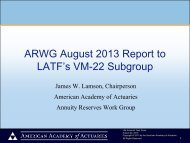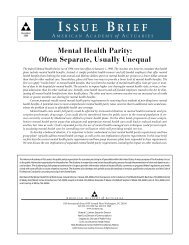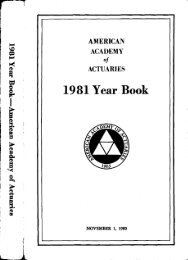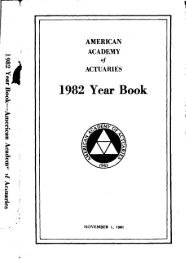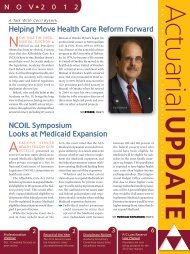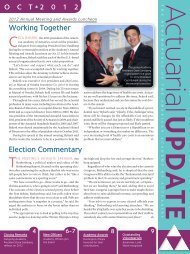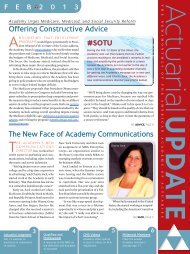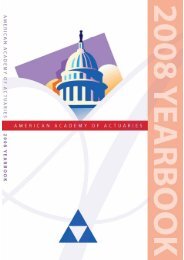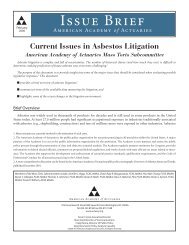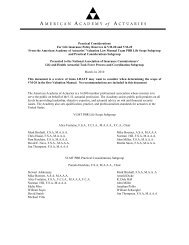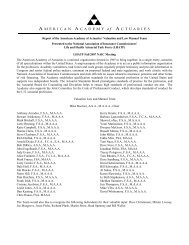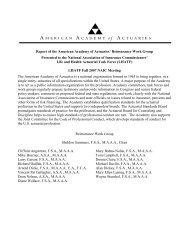Comments - American Academy of Actuaries
Comments - American Academy of Actuaries
Comments - American Academy of Actuaries
You also want an ePaper? Increase the reach of your titles
YUMPU automatically turns print PDFs into web optimized ePapers that Google loves.
Standard M2E3-1<br />
Parameter M2E3-1-<br />
2<br />
Parameter M2E3-1-<br />
4<br />
<strong>American</strong> <strong>Academy</strong> <strong>of</strong> <strong>Actuaries</strong>’ 1 Solvency Committee comments on ComFrame<br />
level and enables the IAIG to<br />
assess its solvency<br />
requirements.<br />
The IAIG has a group-wide<br />
ERM Framework that<br />
addresses all relevant and<br />
material risks at both the<br />
insurance entity and IAIG<br />
level and enables the IAIG to<br />
assess its solvency<br />
requirements.<br />
The IAIG comprehensively<br />
documents its ERM<br />
Framework, emphasizing any<br />
differences that may apply to<br />
different entities within the<br />
IAIG, due to the nature, scale<br />
and complexity <strong>of</strong> the<br />
business conducted locally.<br />
The IAIG’s ERM Framework<br />
is independently reviewed on<br />
a regular basis, at least once<br />
every three years, in order to<br />
ascertain that the ERM<br />
Framework itself remains fit<br />
for purpose.<br />
No relevant IAA reference<br />
No relevant IAA reference<br />
What does it mean to be “fit for purpose”? Since the<br />
guideline says the review may be carried out by others,<br />
how will the reviewers know how to evaluate it?<br />
This document should address how<br />
non-insurance entity risk is to be<br />
addressed.<br />
It seems that this would be more<br />
appropriate for an ICP itself, as long<br />
as an ICP would include a requirement<br />
to emphasize the differences between<br />
the risks as they apply to entities<br />
within an IAIG. While ComFrame<br />
may be trying to get additional<br />
comparative comments into the ERM<br />
documentation, this request might be<br />
better appearing in an ICP rather than<br />
ComFrame itself.<br />
The committee agrees with the<br />
comment and would further pose<br />
another question, what are the<br />
reviewers independent <strong>of</strong>?<br />
Guideline M2E3-1- The review may be carried Is the outcome <strong>of</strong> the review a “clean bill <strong>of</strong> health” or a The committee agrees with the<br />
4-1<br />
out by an internal or external list <strong>of</strong> red, yellow, green comments or a “What is comment and suggests removing the<br />
body but the independent working well and what needs to be better?”<br />
word "independent" here. Since the<br />
reviewer should not be<br />
reviewer may be in the employ <strong>of</strong> the<br />
responsible for, nor have been<br />
IAIG, they are not "independent" in<br />
actively involved in, the part<br />
the usual context <strong>of</strong> the word (e.g.,<br />
<strong>of</strong> the ERM Framework that<br />
"independent auditor").<br />
it reviews.<br />
Parameter M2E3-1- The IAIG articulates its risk My highlights – What examples (and pr<strong>of</strong>essional The committee concurs<br />
1850 M Street NW Suite 300 Washington, DC 20036 Telephone 202 223 8196 Facsimile 202 872 1948 www.actuary.org 7



